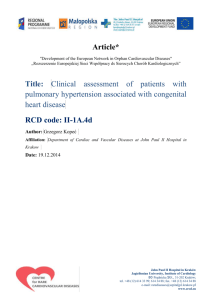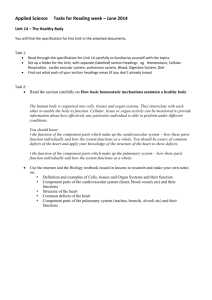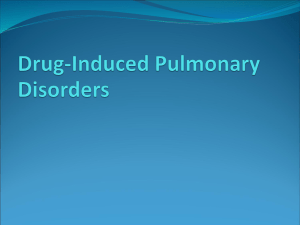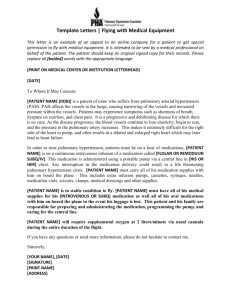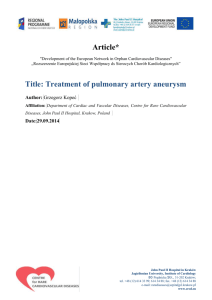Mechanisms of invasive treatment of chronic thromboembolic
advertisement
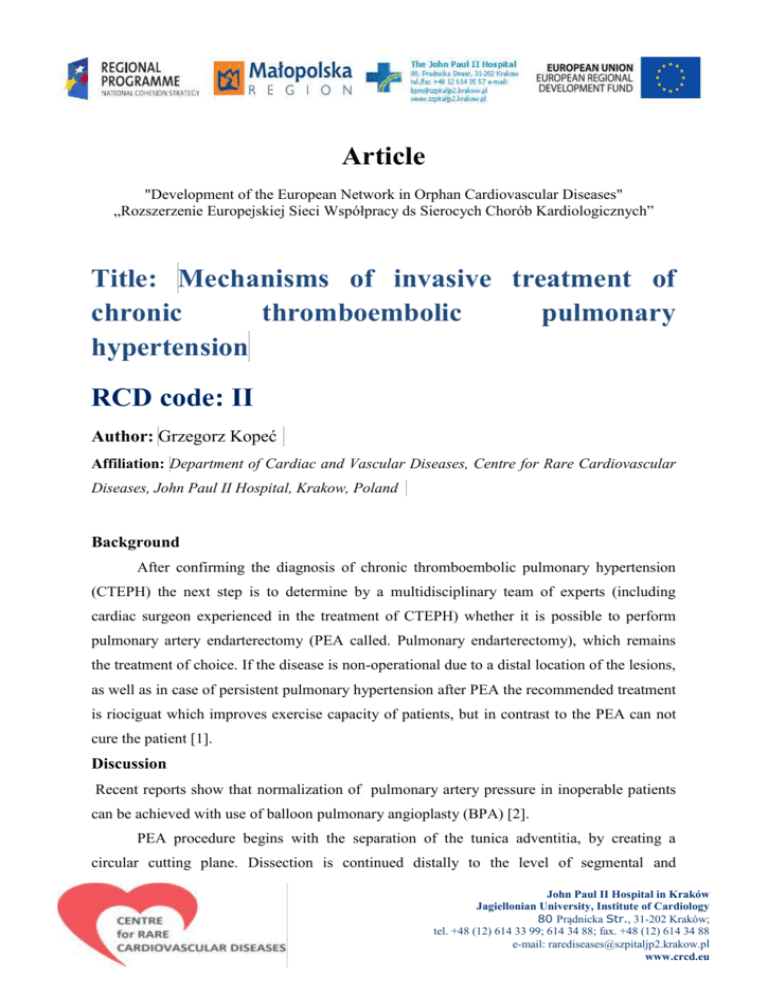
Article "Development of the European Network in Orphan Cardiovascular Diseases" „Rozszerzenie Europejskiej Sieci Współpracy ds Sierocych Chorób Kardiologicznych” Title: Mechanisms of invasive treatment of chronic thromboembolic pulmonary hypertension RCD code: II Author: Grzegorz Kopeć Affiliation: Department of Cardiac and Vascular Diseases, Centre for Rare Cardiovascular Diseases, John Paul II Hospital, Krakow, Poland Background After confirming the diagnosis of chronic thromboembolic pulmonary hypertension (CTEPH) the next step is to determine by a multidisciplinary team of experts (including cardiac surgeon experienced in the treatment of CTEPH) whether it is possible to perform pulmonary artery endarterectomy (PEA called. Pulmonary endarterectomy), which remains the treatment of choice. If the disease is non-operational due to a distal location of the lesions, as well as in case of persistent pulmonary hypertension after PEA the recommended treatment is riociguat which improves exercise capacity of patients, but in contrast to the PEA can not cure the patient [1]. Discussion Recent reports show that normalization of pulmonary artery pressure in inoperable patients can be achieved with use of balloon pulmonary angioplasty (BPA) [2]. PEA procedure begins with the separation of the tunica adventitia, by creating a circular cutting plane. Dissection is continued distally to the level of segmental and John Paul II Hospital in Kraków Jagiellonian University, Institute of Cardiology 80 Prądnicka Str., 31-202 Kraków; tel. +48 (12) 614 33 99; 614 34 88; fax. +48 (12) 614 34 88 e-mail: rarediseases@szpitaljp2.krakow.pl www.crcd.eu subsegmental branches. Then, the material is pulled out of the artery, leaving the thin wall of the vessel [3]. The two available studies based on the histology indicate that the mechanism of BPA is to compress organized thrombus through expanded balon.[4,5] In some cases, an the balloon is expanded in microcanals of the partly recanalized thrombus - the true lumen of the artery is widened. In other cases, the balloon is expanded in the vessel wall which leads to its dissection - filling the balloon moves thrombus to one side of the vessel and produces a false lumen. Own [6] observations indicated that during BPA the organized thrombus is compressed, the lumen diameter increases without increase of the total vessel cross sectional area. The susceptibility of the individual components of organized thrombus to compression is different. References 1. H.-A. Ghofrani, A. M. D’Armini, F. Grimminger, M. M. Hoeper, P. Jansa, N. H. Kim, E. Mayer, G. Simonneau, M. R. Wilkins, A. Fritsch, D. Neuser, G. Weimann, C. Wang, and CHEST-1 Study Group, “Riociguat for the treatment of chronic thromboembolic pulmonary hypertension,” N. Engl. J. Med., vol. 369, no. 4, pp. 319–329, Jul. 2013. 2. H. Mizoguchi, A. Ogawa, M. Munemasa, H. Mikouchi, H. Ito, and H. Matsubara, “Refined balloon pulmonary angioplasty for inoperable patients with chronic thromboembolic pulmonary hypertension,” Circ Cardiovasc Interv, vol. 5, no. 6, pp. 748–755, Dec. 2012. 3. M. M. Madani, W. R. Auger, V. Pretorius, N. Sakakibara, K. M. Kerr, N. H. Kim, P. F. Fedullo, and S. W. Jamieson, “Pulmonary endarterectomy: recent changes in a single institution’s experience of more than 2,700 patients,” Ann. Thorac. Surg., vol. 94, no. 1, pp. 97–103; discussion 103, Jul. 2012. 4. Ogawa, M. Kitani, H. Mizoguchi, M. Munemasa, K. Matsuo, I. Yamadori, A. Andou, and H. Matsubara, “Pulmonary microvascular remodeling after balloon pulmonary angioplasty in a patient with chronic thromboembolic pulmonary hypertension,” Intern. Med., vol. 53, no. 7, pp. 729–733, 2014. 5. M. Kitani, A. Ogawa, T. Sarashina, I. Yamadori, and H. Matsubara, “Histological changes of pulmonary arteries treated by balloon pulmonary angioplasty in a patient with chronic thromboembolic pulmonary hypertension,” Circ Cardiovasc Interv, vol. 7, no. 6, pp. 857–859, Dec. 2014. John Paul II Hospital in Kraków Jagiellonian University, Institute of Cardiology 80 Prądnicka Str., 31-202 Kraków; tel. +48 (12) 614 33 99; 614 34 88; fax. +48 (12) 614 34 88 e-mail: rarediseases@szpitaljp2.krakow.pl www.crcd.eu 6. G. Kopeć, M. Waligóra, J. Stępniewski, K. Żmudka, P. Podolec, and H. Matsubara, “In vivo characterization of changes in composition of organized thrombus in patient with chronic thromboembolic pulmonary hypertension treated with balloon pulmonary angioplasty,” Int. J. Cardiol., vol. 186, pp. 279–281, Mar. 2015. ……………………………………….. Author’s signature* [* Signing the article will mean an agreement for its publication] John Paul II Hospital in Kraków Jagiellonian University, Institute of Cardiology 80 Prądnicka Str., 31-202 Kraków; tel. +48 (12) 614 33 99; 614 34 88; fax. +48 (12) 614 34 88 e-mail: rarediseases@szpitaljp2.krakow.pl www.crcd.eu
